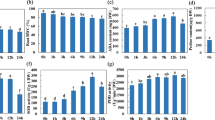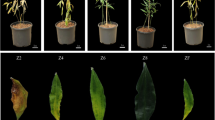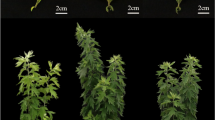Abstract
Key message
The chemical analysis and the expression patterns of related genes were determined to reveal and compare the adaptation mechanism of T. mongolica and Z. xanthoxylum to arid environments.
Abstract
Tetraena mongolica Maxim, the only member of the Tetraena genus in the Zygophyllaceae, is endemic to the northwest of China and is normally accompanied by another plant species in the same taxonomic family, Z. xanthoxylum (Bunge) Engl, and they play a key role in the ecology of the local environment. In order to survive in the local arid environment, many plants have developed a variety of adaptive mechanisms, including the formation of effective protective barrier, such as suberin in the stems and roots that can prevent plants from losing water and improve their adaptability to water-deficient environments. Previous studies have shown that Z. xanthoxylum had stronger drought tolerance than T. mongolica. Here, the water loss rates, the chemical composition of suberin and associated fatty acids in the periderms of stems and roots from T. mongolica and Z. xanthoxylum were determined. The expression level of genes related to suberin and associated fatty acid metabolism of the two species were also analyzed through transcriptome sequencing. The results showed that the stem and root periderms of these two species had similar chemical composition of suberin and fatty acids; however, much higher amount of suberin monomers and fatty acids were found in T. mongolica. Accordingly, transcriptome sequencing showed that more of the differentially expressed genes (DEGs) associated with suberin and associated fatty acid biosynthesis were up-regulated in the stem periderms of T. mongolica; however, minority of DEGs were up-regulated in root periderms of T. mongolica, compared with Z. xanthoxylum. This study lays an important foundation for revealing the adaptation mechanism of T. mongolica and Z. xanthoxylum to arid environments and for comparing the adaptability differences of these two species.







Similar content being viewed by others
Data availability
The transcriptome sequencing raw data were deposited in the National Center for Biotechnology Information with the Accession PRJNA647792 and PRJNA647989.
Abbreviations
- DEGs:
-
Differentially expressed genes
- FPKM:
-
Fragment per kilobase of exon model per million mapped reads
- GC:
-
Gas chromatography
- KEGG:
-
Kyoto encyclopedia of genes and genomes
- qRT-PCR:
-
Quantitative reverse transcription PCR
- VLCFA:
-
Very long chain fatty acids
References
Bao AK, Du BQ, Touil L, Kang P, Wang QL, Wang SM (2016) Co-expression of tonoplast Cation/H(+) antiporter and H(+)-pyrophosphatase from xerophyte Zygophyllum xanthoxylum improves alfalfa plant growth under salinity, drought and field conditions. Plant Biotechnol J 14:964–975
Baxter I, Hosmani PS, Rus A, Lahner B, Borevitz JO, Muthukumar B, Mickelbart MV, Schreiber L, Franke RB, Salt DE (2009) Root suberin forms an extracellular barrier that affects water relations and mineral nutrition in Arabidopsis. PLoS Genet 5:e1000492
Beisson F, Li Y, Bonaventure G, Pollard M, Ohlrogge JB (2007) The acyltransferase GPAT5 is required for the synthesis of suberin in seed coat and root of Arabidopsis. Plant Cell 19:351–368
Beisson F, Li Y, Pollard M (2012) Solving the puzzles of cutin and suberin polymer biosynthesis. Curr Opin Plant Biol 15:329–337
Bonaventure G, Beisson F, Ohlrogge J, Pollard M (2004) Analysis of the aliphatic monomer composition of polyesters associated with Arabidopsis epidermis: occurrence of octadeca-cis-6, cis-9-diene-1,18-dioate as the major component. Plant J 40:920–930
Chen M, Zhao XY (2017) Effect of pollen and resource limitation on reproduction of Zygophyllum xanthoxylum in fragmented habitats. Ecol Evol 7:9076–9084
Chen N, Feng J, Song B, Tang S, He J, Zhou Y, Shi S, Xu X (2019) De novo transcriptome sequencing and identification of genes related to salt and PEG stress in Tetraena mongolica Maxim. Trees 33:1639–1656
Dakhma WS, Zarrouk M, Cherif A (1995) Effects of drought-stress on lipids in rape leaves. Phytochemistry 40:1383–1386
Enstone DE, Peterson CA, Ma F (2002) Root endodermis and exodermis: structure, function, and responses to the environment. J Plant Growth Regul 21:335–351
Fich EA, Segerson NA, Rose JK (2016) The plant polyester cutin: biosynthesis, structure, and biological roles. Annu Rev Plant Biol 67:207–233
Franke R, Schreiber L (2007) Suberin–a biopolyester forming apoplastic plant interfaces. Curr Opin Plant Biol 10:252–259
Freire CS, Silvestre AJ, Neto CP (2007) Demonstration of long-chain n-alkyl caffeates and delta7-steryl glucosides in the bark of Acacia species by gas chromatography-mass spectrometry. Phytochem Anal 18:151–156
Gou M, Hou G, Yang H, Zhang X, Cai Y, Kai G, Liu C-J (2017) The MYB107 transcription factor positively regulates suberin biosynthesis. Plant Physiol 173:1045–1058
Graça J (2015) Suberin: the biopolyester at the frontier of plants. Front Chem 3:62
Heinämäki J, Pirttimaa MM, Alakurtti S, Pitkänen HP, Kanerva H, Hulkko J, Paaver U, Aruväli J, Yliruusi J, Kogermann K (2017) Suberin fatty acids from outer birch bark: Isolation and physical material characterization. J Nat Prod 80:916–924
Höfer R, Briesen I, Beck M, Pinot F, Schreiber L, Franke R (2008) The Arabidopsis cytochrome P450 CYP86A1 encodes a fatty acid ω-hydroxylase involved in suberin monomer biosynthesis. J Exp Bot 59:2347–2360
Kanehisa M, Araki M, Goto S, Hattori M, Hirakawa M, Itoh M, Katayama T, Kawashima S, Okuda S, Tokimatsu T, Yamanishi Y (2008) KEGG for linking genomes to life and the environment. Nucleic Acids Res 36:D480-484
Kang J, Zhao W, Zhu X (2016) Silicon improves photosynthesis and strengthens enzyme activities in the C(3) succulent xerophyte Zygophyllum xanthoxylum under drought stress. J Plant Physiol 199:76–86
Kim D, Langmead B, Salzberg SL (2015) HISAT: a fast spliced aligner with low memory requirements. Nat Methods 12:357–360
Kolattukudy PE (2001) Polyesters in higher plants. Adv Biochem Eng Biotechnol 71:1–49
Krasensky J, Jonak C (2012) Drought, salt, and temperature stress-induced metabolic rearrangements and regulatory networks. J Exp Bot 63:1593–1608
Langmead B, Trapnell C, Pop M, Salzberg SL (2009) Ultrafast and memory-efficient alignment of short DNA sequences to the human genome. Genome Biol 10:R25
Lee SB, Jung SJ, Go YS, Kim HU, Kim JK, Cho HJ, Park OK, Suh MC (2009) Two Arabidopsis 3-ketoacyl CoA synthase genes, KCS20 and KCS2/DAISY, are functionally redundant in cuticular wax and root suberin biosynthesis, but differentially controlled by osmotic stress. Plant J 60:462–475
Leite C, Oliveira V, Miranda I, Pereira H (2020) Cork oak and climate change: disentangling drought effects on cork chemical composition. Sci Rep 10:7800
Li B, Dewey CN (2011) RSEM: accurate transcript quantification from RNA-Seq data with or without a reference genome. BMC Bioinform 12:323
Li Y, Beisson F, Koo AJ, Molina I, Pollard M, Ohlrogge J (2007) Identification of acyltransferases required for cutin biosynthesis and production of cutin with suberin-like monomers. Proc Natl Acad Sci USA 104:18339–18344
Li M, Zhao M, Wu H, Wu W, Xu Y (2013) Cloning, characterization and functional analysis of two type 1 diacylglycerol acyltransferases (DGAT1s) from Tetraena mongolica. J Integr Plant Biol 55:490–503
Livak KJ, Schmittgen TD (2001) Analysis of relative gene expression data using real-time quantitative PCR and the 2-∆∆CT Method. Methods 25:402–408
Ma Q, Yue LJ, Zhang JL, Wu GQ, Bao AK, Wang SM (2012) Sodium chloride improves photosynthesis and water status in the succulent xerophyte Zygophyllum xanthoxylum. Tree Physiol 32:4–13
Ma Q, Bao AK, Chai WW, Wang WY, Zhang JL, Li YX, Wang SM (2016) Transcriptomic analysis of the succulent xerophyte Zygophyllum xanthoxylumin response to salt treatment and osmotic stress. Plant Soil 402:343–361
Ma Q, Hu J, Zhou XR, Yuan HJ, Kumar T, Luan S, Wang SM (2017) ZxAKT1 is essential for K(+) uptake and K(+) /Na(+) homeostasis in the succulent xerophyte Zygophyllum xanthoxylum. Plant J 90:48–60
Nejat N, Mantri N (2017) Plant immune system: crosstalk between responses to biotic and abiotic stresses the missing link in understanding plant defence. Curr Issues Mol Biol 23:1–16
Pollard M, Beisson F, Li Y, Ohlrogge JB (2008) Building lipid barriers: Biosynthesis of cutin and suberin. Trends Plant Sci 13:236–246
Rains MK, Gardiyehewa de Silva ND, Molina I (2018) Reconstructing the suberin pathway in poplar by chemical and transcriptomic analysis of bark tissues. Tree Physiol 38:340–361
Rios P, Cabral V, Santos S, Mori F, Graca J, Products W (2014) The chemistry of Kielmeyera coriacea outer bark: a potential source for cork. Eur J Wood Wood pro 72:509–519
Schreiber L (2010) Transport barriers made of cutin, suberin and associated waxes. Trends Plant Sci 15:546–553
Schreiber L, Franke R, Hartmann K (2005) Wax and suberin development of native and wound periderm of potato (Solanum tuberosum L.) and its relation to peridermal transpiration. Planta 220:520–530
Serra O, Soler M, Hohn C, Sauveplane V, Pinot F, Franke R, Schreiber L, Prat S, Molinas M, Figueras M (2009) CYP86A33-targeted gene silencing in potato tuber alters suberin composition, distorts suberin lamellae, and impairs the periderm’s water barrier function. Plant Physiol 149:1050–1060
Shi S, Wang Y, Zhou H, Zhou J (2012) Comparative analysis of water related parameters and photosynthetic characteristics in the endangered plant Tetraena mongolica Maxim. and the closely related Zygophyllum xanthoxylon (Bunge) Maxim. Acta Ecol Sin 32:1163–1173
Shi F, Zhou X, Yao MM, Zhou Q, Ji SJ, Wang Y (2019) Low-temperature stress-induced aroma loss by regulating fatty acid metabolism pathway in “Nanguo” pear. Food Chem 297:124927
Sun WX, Zhang Q, Jiang JQ (2010) Chemical constituents of Daphne giraldii Nitsche. J Integr Plant Biol 48:1498–1501
Tarazona S, Garcã-A-Alcalde F, Dopazo J, Ferrer A, Conesa A (2011) Differential expression in RNA-seq: a matter of depth. Genome Res 21:2213–2223
Vishwanath SJ, Delude C, Domergue F, Rowland O (2015) Suberin: biosynthesis, regulation, and polymer assembly of a protective extracellular barrier. Plant Cell Rep 34:573–586
Wang Y, Lu M, Duan L (2005) Modified hot phenol method for extracting total RNA from seedling root of cotton. Acta Botan Boreali-Occiden Sin 25:723–726
Wang G, Lin Q, Xu Y (2007) Tetraena mongolica Maxim can accumulate large amounts of triacylglycerol in phloem cells and xylem parenchyma of stems. Phytochemistry 68:2112–2117
Wu GQ, Xi JJ, Wang Q, Bao AK, Ma Q, Zhang JL, Wang SM (2011) The ZxNHX gene encoding tonoplast Na(+)/H(+) antiporter from the xerophyte Zygophyllum xanthoxylum plays important roles in response to salt and drought. J Plant Physiol 168:758–767
Xu X, Xiao L, Feng J, Chen N, Chen Y, Song B, Xue K, Shi S, Zhou Y, Jenks MA (2016) Cuticle lipids on heteromorphic leaves of Populus euphratica Oliv. growing in riparian habitats differing in available soil moisture. Physiol Plant 158:318–330
Xu X, Chen N, Feng J, Zhou M, He J, Zou Y, Shi S, Zhou Y, Jenks MA (2020) Comparative analyses of leaf cuticular lipids of two succulent xerophytes of the Ordos Plateau (Gobi Desert), Tetraena mongolica maxim and Zygophyllum xanthoxylum (Bunge) Engl. Environ Exp Bot 177:104129
Xue D, Zhang X, Lu X, Chen G, Chen ZH (2017) Molecular and evolutionary mechanisms of cuticular wax for plant drought tolerance. Front Plant Sci 8:621
Ye J, Fang L, Zheng H, Zhang Y, Chen J, Zhang Z, Wang J, Li S, Li R, Bolund L, Wang J (2006) WEGO: a web tool for plotting GO annotations. Nucleic Acids Res 34:W293–W297
Yeats TH, Rose JK (2013) The formation and function of plant cuticles. Plant Physiol 163:5–20
Yin H, Li M, Li D, Khan S, Hepworth SR, Wang S (2019) Transcriptome analysis reveals regulatory framework for salt and osmotic tolerance in a succulent xerophyte. BMC Plant Biol 19:88–88
Yu L, Fan J, Xu C (2019) Peroxisomal fatty acid β-oxidation negatively impacts plant survival under salt stress. Plant Signal Behav 14:1561121
Yuan HJ, Ma Q, Wu GQ, Wang P, Hu J, Wang SM (2015) ZxNHX controls Na+ and K+ homeostasis at the whole-plant level in Zygophyllum xanthoxylum through feedback regulation of the expression of genes involved in their transport. Ann Bot 115:495–507
Zhang YJ, Yang C (2000) Comparative analysis of genetic diversity in the endangered shrub Teraena mongolica and its related congener Zygophyllum xanthoxylon. Acta Phytoecol Sin 24:425–429
Zhang YF, Chi Y, Bo LI, Chen JK (2003) Interpopulation difference in growth and reproduction of endemic species Tetraena mongolica in Ordos Plateau. Acta Ecol Sin 23:436–443
Zhi Y, Sun Z, Sun P, Zhao K, Guo Y, Zhang D, Zhang B (2018) How much genetic variation is stored in the endangered and fragmented shrub Tetraena mongolica Maxim? PeerJ 6:e5645
Zhou HB, Wang YC, Shi SL, Zhou JH (2011) Response of antioxidant system in leaves of Tetraena mongolica and Zygophyllum xanthoxylon seedlings to drought stress. Acta Bot Boreali-Occidentalia Sin 31:1188–1194
Zhu GP, Li HQ, Zhao L, Man L, Liu Q (2016) Mapping the ecological dimensions and potential distributions of endangered relic shrubs in western Ordos biodiversity center. Sci Rep 6:26268–26268
Acknowledgements
This research was supported by the National Natural Science Foundation of China (Grant no. 31971409), the First Class University and Discipline Construction Project of Minzu University of China (Yldxxk201819).
Author information
Authors and Affiliations
Corresponding author
Ethics declarations
Conflict of interest
The authors have no conflicts of interest to declare that are relevant to the content of this article.
Ethical standards
T. mongolica is endemic to the western part of Inner Mongolia and Ningxia, Gansu province and also subjected as nationally endangered in China. Before collecting the plant materials and performing the experiments, an oral permission was got from the local management of forestry after applying with introduction letters from College of Life and Environmental Sciences, Minzu University of China.
Additional information
Communicated by Gärtner.
Publisher's Note
Springer Nature remains neutral with regard to jurisdictional claims in published maps and institutional affiliations.
Supplementary Information
Below is the link to the electronic supplementary material.

Fig. S1.
Typical leaf and branching morphology of T. mongolica (a) and Z. xanthoxylum (b) growing in natural habitats of Mengxi, Ordos County, Inner Mongolia. Supplementary file1 (JPG 2400 KB)

Fig. S2.
The suberin monomer content in the periderms of stems (a) and roots (b) from T. mongolica and Z. xanthoxylum. Values represent the amount in μg/cm2 of area for each suberin monomer. Supplementary file2 (JPG 2581 KB)

Fig. S3.
The Unigene KEGG function distribution in the periderms of stems (a) and roots (b) from T. mongolica and Z. xanthoxylum. Supplementary file3 (JPG 2493 KB)

Fig. S4.
The lipid metabolism pathways of All-Unigenes in the periderms of stems (a) and roots (b) from T. mongolica and Z. xanthoxylum. Supplementary file4 (JPG 2086 KB)
Rights and permissions
About this article
Cite this article
Zhou, M., Chen, N., Zou, Y. et al. Comparative analysis of periderm suberin in stems and roots of Tetraena mongolica Maxim and Zygophyllum xanthoxylum (Bunge) Engl. Trees 36, 325–339 (2022). https://doi.org/10.1007/s00468-021-02208-6
Received:
Accepted:
Published:
Issue Date:
DOI: https://doi.org/10.1007/s00468-021-02208-6




